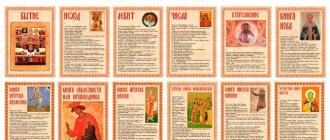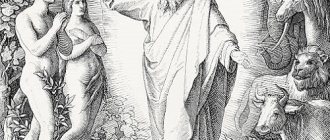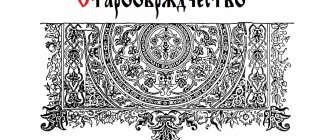Biography - New Testament, philosophy New Books New Works New
Biography
The New Testament (ancient Greek: Καινὴ Διαθήκη) is a collection of books, which is one of two, along with the Old Testament, parts of the Bible. Story. The original texts of the New Testament, which appeared at various times from the middle to the end of the 1st century AD. BC, were written in Koine Greek, which was considered at that time the common language of the eastern Mediterranean. Gradually formed during the first centuries of Christianity, the canon of the New Testament now consists of 27 books - the four Gospels describing the life and preaching of Jesus Christ, the book of the Acts of the Apostles, which is a continuation of the Gospel of Luke, twenty-one epistles of the apostles, as well as the book of Revelation of John the Theologian (apocalypse ). The concept of “New Testament” (lat. Novum Testamentum) in its current understanding is found in the Apostle Paul in the first and second letters to the Corinthians (1 Cor. 11:25, 2 Cor. 3:6). Also, this same concept was used in the Synoptic Gospels by Christ himself (Matthew 26:28, Mark 14:24, Luke 22:20). The concept of “New Testament” was introduced into Christian theology at the end of the 2nd century - at the beginning of the 3rd century in the works of Clement of Alexandria, Tertullian and Origen. Although the very concept of the New Covenant (Hebrew: בְּרִית חֲדָשָׁה) was first used in the book of the prophet Jeremiah: “Behold, the days are coming, says the Lord, when I will make a new covenant with the house of Israel and with the house of Judah” (Jer. 31:31). In pre-Christian times, members of the Jewish Qumran community used the same concept of the New Testament, or New Union (in the sense of union with God). The earliest of the texts of the New Testament are considered to be the epistles of the Apostle Paul, and the latest are the works of John the Theologian. Irenaeus of Lyons believed that the Gospel of Matthew and the Gospel of Mark were written at the time when the apostles Peter and Paul were preaching in Rome (60s AD), and the Gospel of Luke a little later. In addition, according to Jerome: “Matthew... was the first in Judea to compile the Gospel of Christ in Hebrew letters and words for those who believed from circumcision; who then translated it into Greek is not well known” (De vuris inlustribus III).
Canonization of the New Testament. The books of the New Testament were canonized by the Christian Church at the Ecumenical Councils. Problems arose only with two books. In the East, the Revelation of John the Theologian was considered too mystical a book (it is still not read during services), and in the West they doubted the authorship of one of the Epistles of Paul. The so-called Muratori canon is known, named after the Milanese librarian who discovered in the 18th century an ancient papyrus fragment listing the canonical books of the New Testament. The fragment dates back to approximately 200, and lacks a number of works that later became part of the canon: Paul’s Epistle to the Hebrews, both Epistles of Peter, the Third Epistle of John, and the Epistle of James. But this canon includes the Apocalypse of Peter, which was later classified as apocrypha. The question of including the Apocalypse of John in the canon has long been controversial. The Laodicean local church council (364) approved the New Testament canon consisting of 26 books, which still constitute it today, without the Apocalypse. After this, the issue of the New Testament canon was discussed at two more local councils, the Council of Hippo (393) and Carthage (397), and was finally adopted by the second rule of the Fifth-Sixth Council (Trullo) (692). A large number of works of early Christian literature have been considered apocryphal. The Ethiopian Church has adopted a non-standard canon of the New Testament (it includes several books considered apocryphal by other Christians). Gospel texts are anonymous. Each of the Gospels was attributed to a specific author in the early second century.
The problem of language. Original Christianity spoke the language of the society from which it emerged. At the time of Jesus Christ, the most common languages in the Holy Land were Greek (Koine), Aramaic, and to a limited extent Mishnaic Hebrew, which was used primarily as a language of worship. Most scholars believe that the original texts of the New Testament were written in the Koine Greek dialect, which was the lingua franca of the Roman Empire's Eastern Mediterranean provinces in the 1st century AD. e. Later the texts were probably translated from Greek into other languages (Latin, Syriac, Coptic). It has been suggested, including by some of the Church Fathers of the 2nd and 3rd centuries, that the Gospel of Matthew was originally created in Hebrew or Aramaic, and the Epistle to the Hebrews was originally written in Hebrew and then translated by the Evangelist Luke into Greek. However, such assumptions have not found serious support among modern experts, who, based on the literary aspects of the texts of Matthew and the Epistle to the Hebrews, come to the conclusion that these works were also directly created in Koine. A significant minority of scholars consider the Aramaic version of the New Testament to be original, and consider the Greek texts to be translations. In particular, some Syriac scholars believe that the New Testament was originally written in the Galilean dialect of Aramaic (which is closely related to Syriac).
Textology. The number of known manuscripts of the New Testament greatly exceeds the number of manuscripts of any other ancient document (24 thousand manuscripts for the New Testament and 643 manuscripts for Homer's Iliad, the next largest list of texts known). Moreover, the time interval between the writing of the original and the date of the earliest extant manuscript of the New Testament is significantly less than this indicator for copies of the works of classical authors (20-30 years for the New Testament versus 1400 years for the most ancient reliable list of plays by Sophocles, which are considered extant essentially in its exact form).
Interpretation of the New Testament
The name “New Testament” comes from the Latin name “Novum Testametum”, which in turn is a translation from the Greek “He kaine Diateke”.
The Greek term was used more to mean "last will or testament." Since the “will” is the best example of this document, the Latin word “Testamentum” was used, which in Russian translation is “Testament”.
A covenant is a contract that includes two valid parties. The covenant obliges both parties to fulfill what is promised, without any room for error.
An example of such a covenant is the passage in Scripture, Ex. 24: 1 - 8 , which describes the adoption of the law by the people of Israel on Mount Sinai. It follows that the New Testament is a description of God's new agreement with people through Jesus Christ. The Lord God puts forward conditions that a person can accept or reject, but cannot influence their changes.
At the time when a person accepts the terms of the covenant, then together with God they are obliged to fulfill all the requirements according to the concluded “contract”.
God gives us a choice. Lets go free swimming. But at the same time he always lends a helping hand
“The New Testament embodies the revelation of God's holiness in a perfectly righteous Son, who gives to those who receive this revelation the power to become sons of God by making them righteous” ( John 1:12 ).
Literary Character of the New Testament
The first five books of the New Testament: Matthew, Mark, Luke, John and the Acts of the Apostles are purely historical in nature. These are narratives. The first four books describe the life of Christ. Acts and the Gospel of Luke tell the stories of Jesus' disciples, focusing on the life of the Apostle Paul.
The books from Romans to 1 John are doctrinal in nature. Most of them are written in the form of letters to churches with the purpose of teaching the basics of righteous living and faith in God.
Other books are personal: 1 and 2 Timothy, Titus, Philemon, 2 and 3 John. They were written exclusively as personal letters to certain people with the aim of guiding them on the right path.
The Book of Revelations is prophetic in nature. It describes the future and the present. Due to its highly symbolic style, it also falls into the category of apocalyptic literature.
Armenian Bible translation
The Armenian translation of the Bible has been called the “Queen of Translations.” This title is well deserved. The Armenian translation is unique in that it conveys the New Testament clearly, accurately, literally - and at the same time has an excellent style. The text underlying it is also of interest.
The origin of the Armenian version is shrouded in mystery. We have several historical documents, but they do not help answer questions, but rather add new ones to existing ones.
Joseph M. Alexanian, who has done one of the recent studies on this matter, states that the first Armenian translation (Armenian 1) was made from the Old Syriac text in 406-414 AD. It was followed by a revised translation (Armenian 2), made from the Greek text after the Council of Ephesus in 431. It suggests that other revised editions appeared subsequently.
In assessing Aleksanyan's statement, it should be remembered that there are no Armenian manuscripts from that period. As for the references belonging to the “church fathers,” despite their huge number, they were not sufficiently studied or cataloged.
Armenia is closely related to Syriac Christianity. The country officially converted to Christianity before Emperor Constantine, in an era when the only Christian states were a few Syrian principalities such as Edessa. It would be quite logical to assume that the first Armenian translations bear signs of strong Syrian influence.
Evidence of Syrian influence is indeed present (including manuscripts containing 3 Corinthians and not Philemon), but there are also signs of Greek influence. Moreover, the Armenian text does not correspond either to the surviving Old Syriac translations or to Pshita. Obviously it is much more related to the “Caesarean” text. In fact, the Armenian translation is the best evidence for the existence of this text.
History of translation - history of writing
The history of Armenian translation is closely connected with the history of the emergence of Armenian writing. After an unsuccessful attempt by a confessor named Daniel, Mesrop, a friend and collaborator of the head of the Armenian church, Sahak, is said to have created the Armenian alphabet. It is reported that this was in 406, and the impetus for the creation of writing is believed to have been the need to write down the Armenian Bible. The said translation was completed twelve or so years after Mesrop's work began.
We can talk with less confidence about the text that served as the basis for the translation. Many scholars have argued for both a Syriac and a Greek original. There are passages in which the wording favors a Syriac text, but others present a strong case for a Greek basis.
There are at least three explanations for this:
- One is that the Armenian translation was made from Greek, but the translator knew the Syriac version very well.
- Another assumption is that the Armenian translation was created in several stages. At an early stage, a variant of the Old Syriac translation, or perhaps the Syriac Diatessaron, was probably translated. Later it was corrected according to the original Greek, and possibly also to the “Caesarean” text. Further revisions apparently increased the number of Byzantine passages in the text.
- Finally, it is quite possible that there were two separate translations (Conibeare believes that Mesrop translated from Greek and Sahak from Syriac), which were eventually combined into one.
Canon of the New Testament
In a previous article about the history of the creation of the Old Testament, we already defined what a canon is.
Let us remind you that it means “rod” or “reed”. In grammar, this word denotes a rule of procedure; in chronology – a table of dates; and in literature - a list of works by a specific author.
It turns out that if the canon of the New Testament cannot be established with accuracy, then it loses its authority and, thus, is not a solid measure of faith and time.
But the canon cannot be decided solely by the question of authorship. Nine different people wrote his books, and there is no special ruler that was used to measure, measure and select these nine people.
There is no definite explanation why, for example, Philip was not inspired to write the gospels as Matthew was.
A canon cannot be established solely on the basis of the church's acceptance of books. Some books were accepted universally and with joy, others were accepted hesitantly by some churches and not accepted at all by others, and still others were not mentioned until later times, or their right to be in the canon was subject to debate.
The true criterion of canonicity is inspiration.
“All Scripture is given by inspiration of God and is profitable for teaching, for reproof, for correction, for instruction in righteousness, so that the man of God may be complete, equipped for every good work” ( 2 Tim. 3:16-17 ).
In other words, what was given through Divine inspiration is Scripture .
Be inspired by God. And you will succeed
As for the content of the books of the New Testament, the person of Christ and His ministry are at the center of all. The Gospels are biographical in nature; Acts describes the historical consequences of His personality. The Epistles are theological and practical teachings which flow from the consideration of His person, and the Apocalypse foretells His relation to the future.
The New Testament writings are not only useful, but also powerful for man.
From the very beginning, certain pieces of information and concepts of the word about Christ were passed on from one person to another as the Word of God.
In Galatians, Paul argued that his gospel “is not of men; for I also received Him and learned Him, not from man, but through the revelations of Jesus Christ” ( Gal. 1:11,12 ).
In 1 Corinthians 15:3,4, Paul defines his gospel as the word “which he also himself received, that is, that Christ died for our sins according to the Scriptures.”
Thus, from the very beginning of his writing career, Paul looked upon his writings as the authoritative Word of God.
Not all New Testament writings contain such references, but all have this self-authoritative quality. The Gospels are devoted almost entirely to quotes from Christ and descriptions of His deeds.











